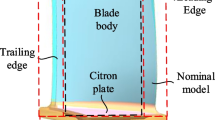Abstract
Presently, the quality evaluation of long blade profile is still mainly based on the specific cross section, focusing on the twist, position, and profile errors. However, the common registration methods of blade profiles only focus on profile error and ignore other important parameters, which may results in misjudgment of qualified blade or increasing the scrap rate. So, a new global-to-local registration and error evaluation method for a long blade is proposed in this paper. Based on the parameter priority, the registration of the blade is completed from global fine registrations to local fine registrations. The best-fit algorithm is used for global fine registration to screen out the qualified blades firstly. Then, the unqualified results are further optimized by the coordinate alternation method in the local fine registration to guarantee the evaluation result qualified as far as possible. The experimental results show that the proposed method reduces the misjudgment effectively by keeping the more important parameters in the tolerance range. And it is beneficial and practical to guide blade finish machining or repairing because the difficult finish machining or repairable machining parameters are priority to guarantee in the allowable error range.
Similar content being viewed by others
References
Chady T, Sikora R, Lopato P, Psuj G, Szymanik B, Balasubramaniam K, Rajagopal P (2016) Wind turbine blades inspection techniques. Organ 5:16
Anoshkin AN, Osokin VM, Tretyakov AA, Potrakhov NN, Bessonov VB (2017) Application of operational radiographic inspection method for flaw detection of blade straightener from polymeric composite materials. J Phys: Conf Ser. IOP publishing 808(1):012003
Dervilis N, Maguire A E, Papatheou E, Worden K (2017) Wind turbine health monitoring: current and future trends with an active learning twist. Rotating machinery, hybrid test methods, vibro-acoustics & laser vibrometry, volume 8. Springer, Cham 119–129
Smith L, Karim H, Etemad S (2006) The gas turbine handbook. Bruxelles Médical 35(35):1401–1408
Khameneifar F, Feng H Y (2016) Extracting sectional contours from scanned point clouds via adaptive surface projection. Int J Prod Res 1–15
Wen X, Zhao Y, Wang D, Zhu X, Xue X (2013) Accurate evaluation of free-form surface profile error based on quasi particle swarm optimization algorithm and surface subdivision. Chin J Mech Eng 26(2):406–413
Hsu TH, Lai JY, Ueng WD (2006) On the development of airfoil section inspection and analysis technique. Int J Adv Manuf Technol 30(1–2):129–140
Sijie Y, Yunfei Z, Fangyu P, Xide L (2004) Research on the localisation of the workpieces with large sculptured surfaces in NC machining. Int J Adv Manuf Technol 23(5–6):429–435
Grant D, Bethel J, Crawford M (2012) Point-to-plane registration of terrestrial laser scans. ISPRS J Photogramm Remote Sens 72:16–26
Dai J, Chen Z, Ye X (2007) The application of ICP algorithm in point cloud alignment. J Image Graphics 12:517–521
Du S, Zheng N, Ying S, Liu J (2010) Affine iterative closest point algorithm for point set registration. Pattern Recogn Lett 31(9):791–799
Besl P J, McKay N D (1992) Method for registration of 3-D shapes. Robotics-DL tentative. International Society for Optics and Photonics 586–606
Hsu TH, Lai JY, Ueng WD, Hwang JZ (2005) An iterative coordinate setup algorithm for airfoil blades inspection. Int J Adv Manuf Technol 26(7–8):797–807
Ji S, Ren Y, Ji Z, Liu X, Hong G (2017) An improved method for registration of point cloud. Optik-Int J Light and Electron Opt 140:451–458
Zhang B, Fang J, Liu P (2016) A registration method for 2D blade profile. International Symposium on Optoelectronic Technology and Application 1015528-1015528-10
Kwok TH, Tang K (2016) Improvements to the iterative closest point algorithm for shape registration in manufacturing. J Manuf Sci Eng 138(1):011014
Yu J, Chen Z, Jiang Z (2016) An approach for machining distortion measurements and evaluation of thin-walled blades with small datum. Chin J Aeronaut 29(6):1806–1814
Jing SK, Cheng YY, Zhang DH, Yang HC (2010) Tolerance zone constrained alignment method for turbine blade model. Comput Integr Manuf Syst 16(4):883–886
Li W, Xie H, Zhang G, Yan SJ, Yin ZP (2016) 3-D shape matching of a blade surface in robotic grinding applications. IEEE/ASME Trans Mechatronics 21(5):2294–2306
Khameneifar F, Feng HY (2016) A new methodology for evaluating position and orientation errors of airfoil sections. Int J Adv Manuf Technol 83(5–8):1013–1023
Shulong HU, Zhang D, Zhang Y (2013) Inspection method of blade shape based on digitized template with design tolerance constraints. Acta Aeronautica Et Astronautica Sinica 34(10):2411–2418
Lin X, Yan G, Wu G, Fan NJ, Jiang B, Gao XF (2013) CMM measuring data processing algorithms for blades about the contour measurement. Yi Qi Yi Biao Xue Bao/Chinese J Sci Instrum 34(11):2442–2450
Rong Y, Xu J, Sun Y (2014) A surface reconstruction strategy based on deformable template for repairing damaged turbine blades. Proc Inst Mech Eng Part G: J Aerospace Eng 228(12):2358–2370
Vassiliadis V S, Conejeros R (2008) Cyclic coordinate method. Encyclopedia of Optimization Springer US 595–596
Wright SJ (2015) Coordinate descent algorithms. Math Program 151(1):3–34
Ma W, Kruth JP (1998) NURBS curve and surface fitting for reverse engineering. Int J Adv Manuf Technol 14(12):918–927
Brujic D, Ainsworth I, Ristic M (2011) Fast and accurate NURBS fitting for reverse engineering. Int J Adv Manuf Technol 54(5–8):691–700
Funding
This work was funded by National Natural Science Foundation of China (No. 61377104 and No. 61405156).
Author information
Authors and Affiliations
Corresponding authors
Rights and permissions
About this article
Cite this article
Huang, J., Yuan, Y., Wang, Z. et al. A global-to-local registration and error evaluation method of blade profile lines based on parameter priority. Int J Adv Manuf Technol 94, 3829–3839 (2018). https://doi.org/10.1007/s00170-017-1125-0
Received:
Accepted:
Published:
Issue Date:
DOI: https://doi.org/10.1007/s00170-017-1125-0



